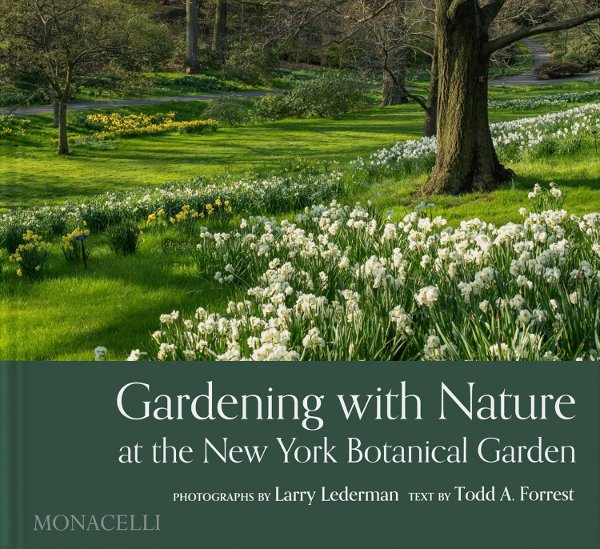
Gardening with Nature at the New York Botanical Garden
Photographed by Larry Lederman, written by Todd A. Forrest, foreword by Jennifer Bernstein
Released in April 2025 by The Monacelli Press
.
All content included on this site such as text, graphics and images is protected by U.S and international copyright law.
The compilation of all content on this site is the exclusive property of the site copyright holder.
Gardening with Nature at the New York Botanical Garden
a book review
Friday, 21 March 2025
New York City with its skyscrapers, sidewalks, pavement, where trees are isolated in tree pits carved out of pavement . . . In the heart of the New York Botanical Garden is the largest remnant of old growth forest that once covered much of what is now New York City. A canopy of centuries-old oaks, tulip trees, sweetgums, maples, and other native hardwoods inhabit the 50-acres of the Thain Family Forest. It is a marvellous remnant of what once was, when gardening was managed by nature. There is now a wonderful book that is not only profusely illustrated with excellent images but also with text that explains the what / why / when of the the New York Botanical Garden.

Gardening with Nature at the New York Botanical Garden
Photographed by Larry Lederman, written by Todd A. Forrest, foreword by Jennifer Bernstein
Released in April 2025 by The Monacelli Press
There are all these "ages", geological periods when there were changes, for example when ice covered more of the world, time when the ice retreated. Perhaps you have heard that we are now living in the Anthropocene, meaning the time during which humans have had a substantial impact on our planet. Changes within our lifetimes that have affected plants.
A section about the Thain Family Forest and the Bronx River has a wonderfully informative text by Todd Forrest, Vice President for Horticulture and Living Collections. Chestnut blight first detected in 1904 at the Bronx Zoo devastated American chestnut forests in the early 20th century. Woolly ageldid attacking hemlocks. Emerald ash borer. Beech leaf disease. Insects and nematodes that arrived from Asia in packing material and / or nursery stock. As native species such as hemlocks in the Thain family forest decline, populations of invasive species increase. What to do? Goals are to accommodate access to the Forest for research, education, and enjoyment, and develop and employ ecologically sound restoration practices to deal with the most pressing human-caused threats to its health. Treatment with insecticides may help individual trees if the issue is detected early enough. However, Todd Forrest points out, until the pests are extirpated, insecticides may be needed for generations to come.
Larry Lederman's handsome images share vignettes and overviews around the four seasons.
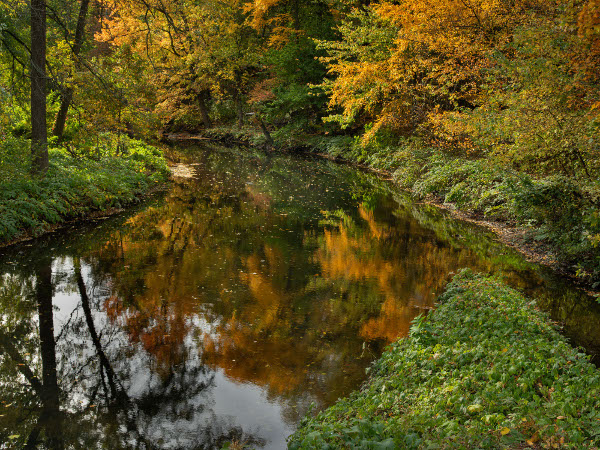
Image provided by publisher. Copyright Larry Lederman, all rights reserved
Captions explain. "We are experimenting with ways to control knotweed,
which has become established along the banks of the Bronx River."
I have deer wandering around, often quite near the house. They consider my garden a buffet, a salad bar upon which to browse. That is one reason why I especially enjoy daffodils when they appear each spring - they are not on Bambi's menu.
The next section of the book has a focus on Daffodil Hill. It first explores, discusses the early days of the New York Botanical Garden, when Nathaniel Britton took the approach that a natural approach would best serve plantings in NYBG's natural landscape. Today, crabapples add structure along the edge of Daffodil Hill in winter, late spring flowers. Two images, one bare branches and snow, the other green grass, crabapples in flower, canopy trees leafing out,
But it is the several images of the daffodils that give the hill its name that add vibrancy to the story.
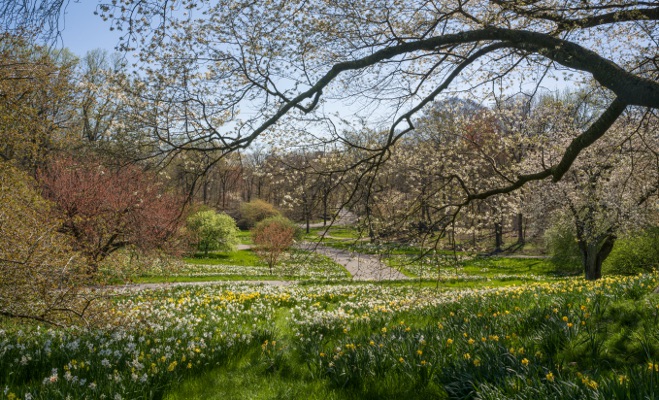
Image provided by publisher. Copyright Larry Lederman, all rights reserved
Very readable is the story of 60,000 daffodils, planted in the mid 1920s. Projects begun, gardens moved.
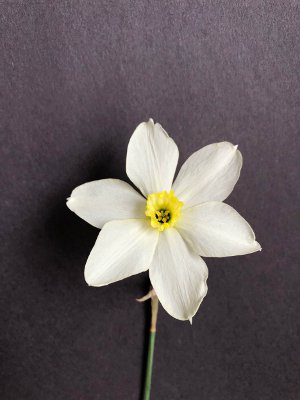
Image provided by publisher. Claire Lyman, NYBG, all rights reserved
Narcissus 'Queen of the North', an heirloom daffodil that has survived at NYBG since planted in the 1920s.
Nearly 30 of the heirloom varieties planted a century ago have been identified. Bulbs are lifted, divided, and
replanted, so these historic daffodils will continue to survive. A very readable story, beautifully illustrated.
Daffodils are true survivors, many thriving with benign neglect (if first planted in suitable conditions.
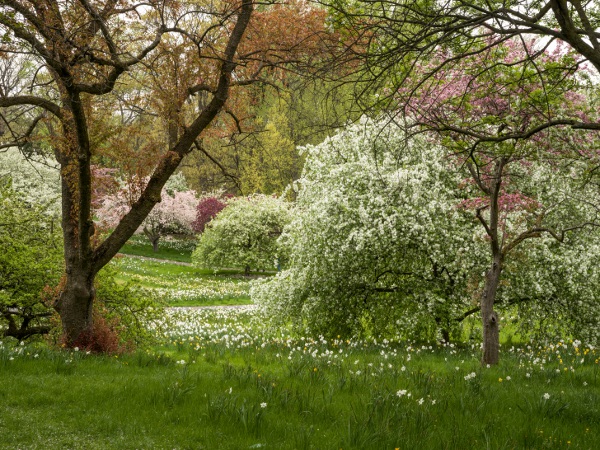
Image provided by publisher. Copyright Larry Lederman, all rights reserved
On the eve of NYBG's 125th anniversary, the Million Daffodil project began with 150,000 daffodils planted
in fall 2015. A special bulb planting machine from the Netherlands aided the work, more planted every year.
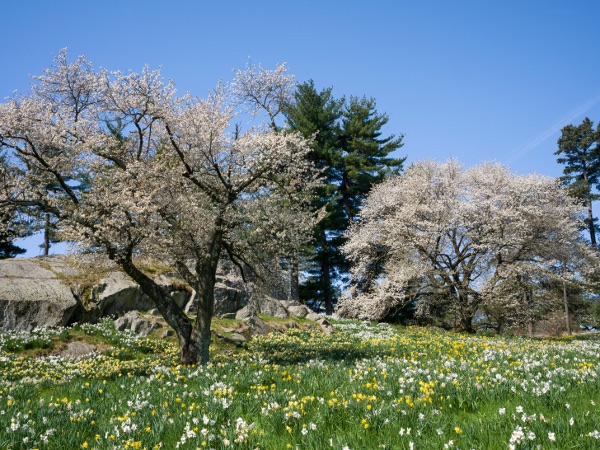
Image provided by publisher. Copyright Larry Lederman, all rights reserved
Let me step aside from this review for a moment. Should you now be curious to see what is in bloom
at NYBG paste this link https://www.nybg.org/spring-bloom-trackers/ into your browser for a virtual look.
NYBG has some massive rock outcrops, scraped and scoured by the glaciers that 20,000 years ago with ice about 1,000 to 2,000 feet thick. On the same theory of lemons make lemonade, these are now incorporated into the gardens and landscapes that work with nature. The T. H. Everett rock garden is remarkable, incorporating as it does not only existing outcrops but also other massive stones moved onto the site back in 1934, utilizing actual horses for the required horsepower. The Rock Garden chapter includes several historical black and white images from the collections of NYBG's Mertz Library.
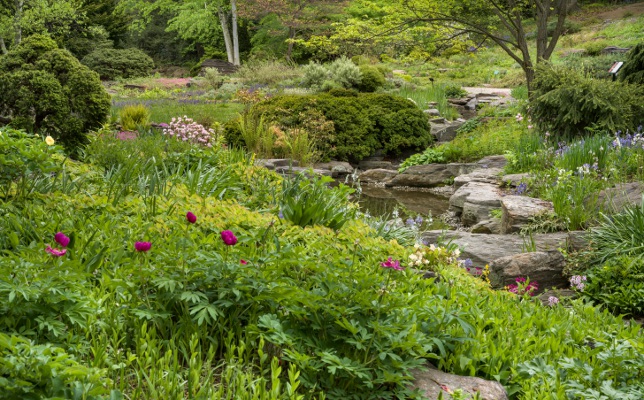
Image provided by publisher. Copyright Larry Lederman, all rights reserved
contemporary images by both Larry Lederman and Marlon Co, NYBG photographer, show how wonderfully
this rockwork continues as a foundation for the specialized garden, displaying both the rocks and the plants
which thrive among them. Todd Forrest's text explores the garden's construction but also ecologically sound
improvements. In 2014, renovation changes to the cascade, stream, and pond from an open tap to recirculating
system. As well, the whole system - cascade, stream, pond - were relined to minimize water loss. Visitors today
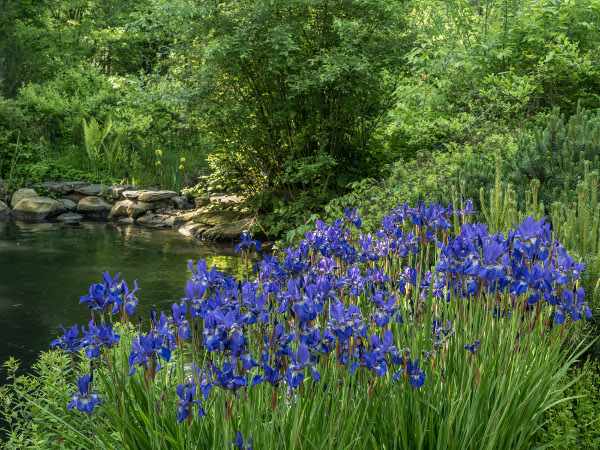
Image provided by publisher. Copyright NYBG, image by Marlon Co, all rights reserved
enjoy the beauty of the T.H. Everett Rock Garden. Readers of Gardening with Nature at the New York Botanical Garden
will enjoy learning of its history and continuing care provided by a seamless pairing of informative text and lovely images.
.
Other portions of NYBG are given similarly thorough exploration: Daffodil Valley, near the education building. The Maureen K. Childtern Azalea Garden, where a path leads visitors along a gently sloping, rising path among mature trees and masses of azaleas (magnificent in spring.) Native Plant Garden. Coleman and Susan Burke Oak Collection. Most of these are illustrated with luscious images displaying seasons of active growth and display, just a few of autumn and winter's time of rest.
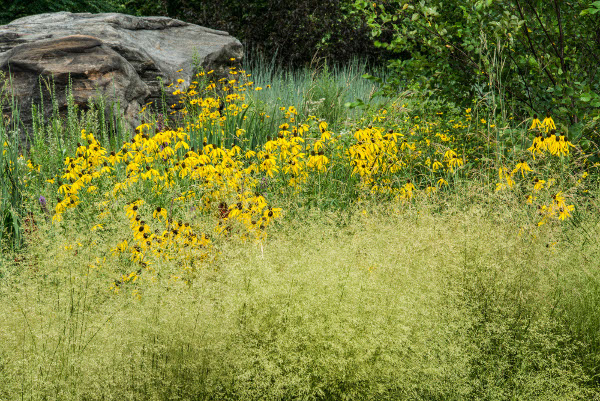
Image provided by publisher. Copyright Larry Lederman, all rights reserved
Yellow coneflowers in the native plant garden's meadow, above a foglike mass of tufted hair grass.
An afterword by Larry Lederman explains that this, the third collaboration in which he and Todd Forrest have explored the New York Botanical Garden. It is the conclusion, their last book. Rather than beautifully presenting what you see (I hesitate to say "merely") this excellent book explores, describes, illustrates the multigenerational history and achievements that is the New York Botanical Garden today. Easy reading, superb pictures. A delightful book that will, no doubt, encourage more visitors to come and enjoy NYBG in person. Until then, read the book.
Gardening with Nature at the New York Botanical Garden
Photographs by Larry Lederman, text by Todd A. Forrest, foreword by Jennifer Bernstein
First published in the United States by The Monacelli Press.
ISBN 97815809836279
hardbound, $59.95
A review copy of this book was provided by the publisher
Back to March
Back to the main Diary Page